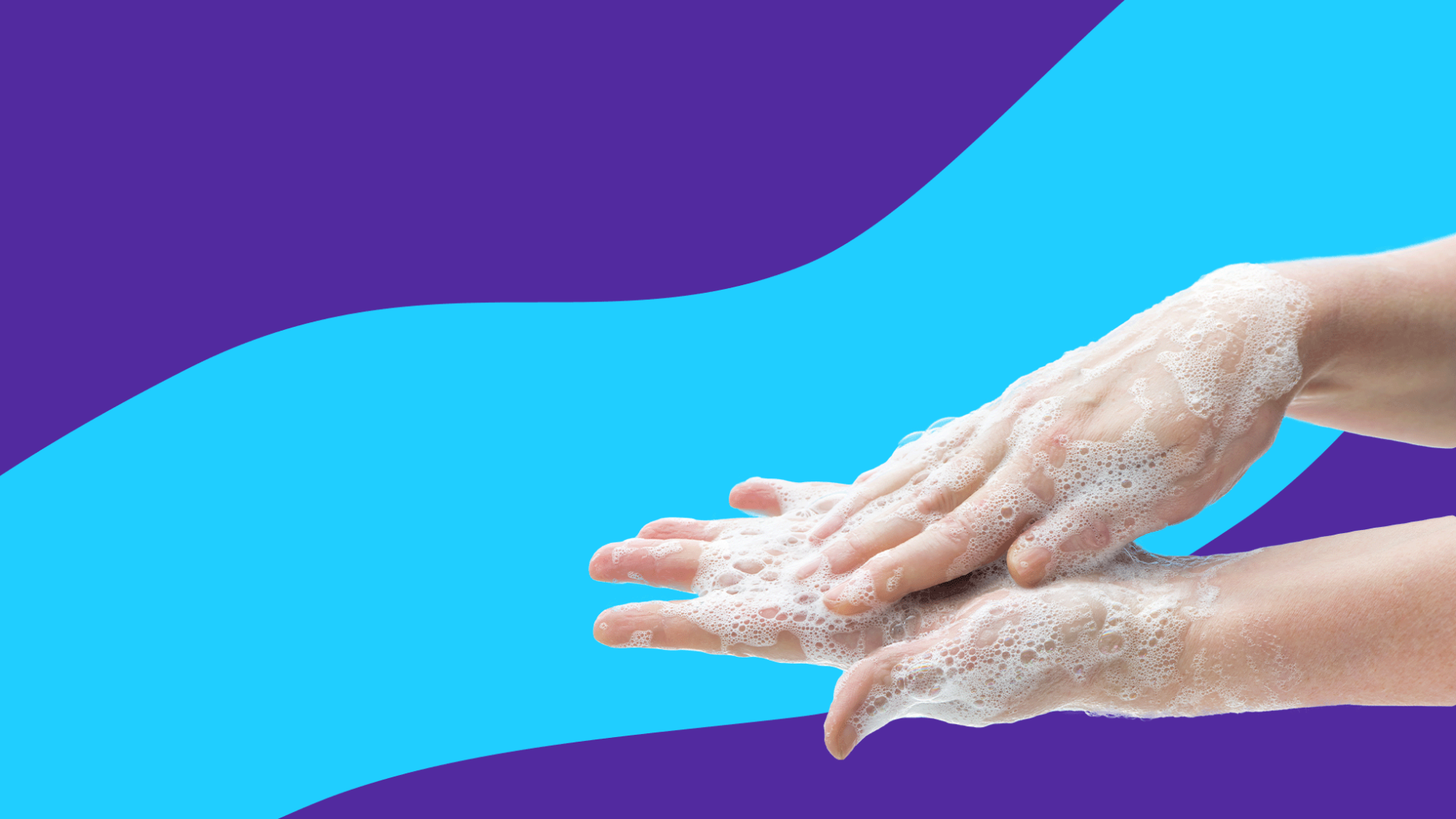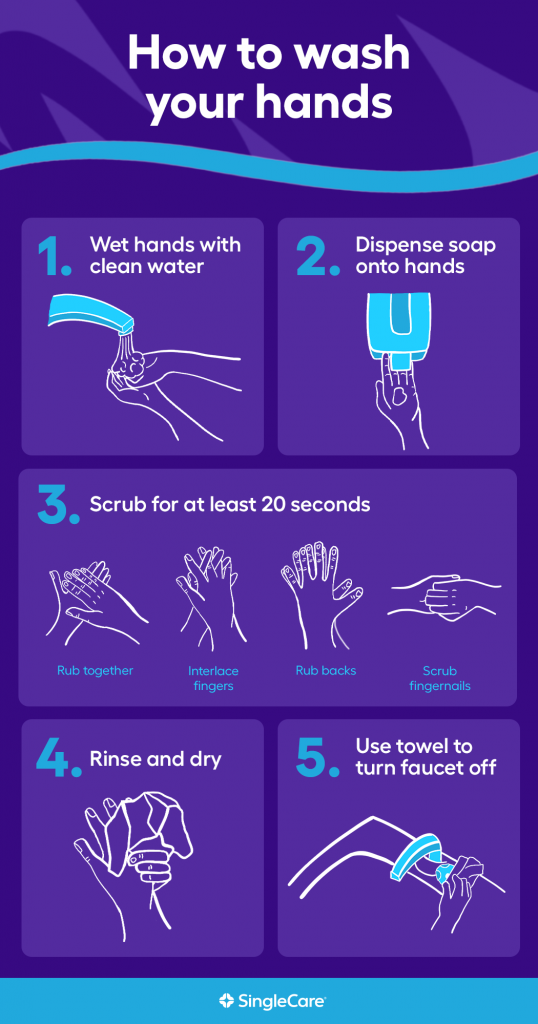Handwashing is one of the best and easiest ways to prevent all kinds of infections, from seasonal colds and flus to COVID-19. However, you might be doing it wrong… or at least not nearly as often as you should. Here’s what you need to know about when to wash your hands, how to wash your hands properly, and when you can substitute hand sanitizer for soap and water.
By the numbers: Why handwashing is important
Bacterial and viral illnesses spread in a variety of ways, but transmission primarily happens through contact with contaminated surfaces or by breathing in infected respiratory droplets. Some illnesses are also spread through food, fecal matter, contaminated water sources, or open wounds on the skin.
But the biggest source of transmission by far is contact: when you touch a surface contaminated with viral particles or bacteria and then touch your eyes, nose, or mouth, you give germs an opportunity to enter your body in a way that can make you sick. And most of the common surfaces we touch every day—like cell phones, doorknobs, communal chairs and tables, subway railings—are basically giant petri dishes.
- About 80% of infections are spread by hands, says Tasneem Malik, MD, a primary care physician at Mercy Medical Center. This includes GI infections, like salmonella and norovirus, and respiratory infections, like the common cold, influenza, and coronavirus disease.
- Community education efforts around handwashing can reduce the amount of viral diarrhea cases by 23% to 40% and the number of respiratory illnesses by 16% to 21%, per the Centers for Disease Control and Prevention (CDC).
- Many perfectly healthy people are carriers of the Staphylococcus aureus bacteria, which is often responsible for severe skin infections like the antibiotic-resistant MRSA.
- A 2020 YouGov poll suggests that as many as 40% of Americans don’t regularly wash their hands with soap and water after using the bathroom at home.
- Frequent handwashing may help prevent antibiotic overuse and resistance.
Without frequent handwashing, it’s pretty easy to swap germs with someone who has just changed a diaper or used a bathroom without washing up afterward. (Gross, we know…but it’s the truth!) Luckily, handwashing can go a long way toward keeping you healthy.
When to wash your hands
Now that you know how important it is to wash up, it’s time to talk frequency: Just how often should you be washing your hands to prevent illness?
The short answer? Frequently, says Susan Besser, MD, a primary care physician with Mercy Personal Physicians at Overlea.
“There really isn’t a set amount, but [you should wash your hands] anytime you touch a potentially contaminated surface, use the restroom, before eating, or if you blow your nose or sneeze or cough into your hand,” Dr. Besser explains.
Need more info? Here are a few other scenarios that call for soap and water:
| You should wash your hands if you… |
| …have changed a diaper |
| …are about to prepare a meal |
| …are caring for a sick person at home or work |
| …before and after disinfecting a wound |
| …after taking out the trash |
| …after touching animal waste (i.e., changing your cat’s litter box or picking up your dog’s poop) |
| …after touching pet food or pet treats, which can be contaminated with bacteria like salmonella |
| …before touching your face to scratch an itch, apply makeup, or insert contact lenses |
How to wash your hands properly
Ready to get down to business? Here’s how to wash hands effectively—you’re going for “doctor preparing for surgery” here, not “toddler rinsing their hands for three seconds with warm water,” especially during the COVID-19 pandemic.
- Wet hands with clean water. Contrary to popular belief, the water does not have to be warm; the important things here are the soap and the scrubbing, not the temperature of the water.
- Dispense enough soap to cover the surface of your hands. You don’t need to use soap that’s labeled antibacterial. While these certainly get the job done, there’s no evidence that they work better than regular soap. When used properly, regular soap is in fact “antibacterial” since it is effective in ridding the hands of bacteria and other virus-causing germs.
- Start scrubbing: Make sure you rub your palms together, use alternating palms to lather the backs of your hands up to your wrists, interlace your fingers and scrub in between each one, use alternating palms to rub each one of your thumbs, and scrub the tops and edges of your fingernails in each opposing hand. It’s important to apply soap to every part of your hands, fingers, and thumbs, including all the hard-to-reach nooks and crannies.
- How long do you need to wash your hands? At least 20 seconds. An easy trick is to sing “Happy Birthday” to yourself twice in a row.
- When you’re done, rinse the soap off your hands with water and thoroughly dry hands with a clean paper towel. In public places, paper towels are preferred over air dryers, since the towel is more effective in drying hands completely, and the manual action of rubbing your hands on the paper towel is another protective layer of ridding them of unwanted germs. At home, clean cloth towels are okay but should be laundered frequently, especially if shared by family members or guests. Paper towels are always the best option.
- If you’re in public, use the paper towel to turn off the faucet; otherwise, you risk re-contaminating your clean hands. If possible, use a paper towel to open the bathroom door handle as you leave (and discard of it ASAP).
Can you wash your hands for too long?
Technically, you can wash your hands for too long—but this warning has more to do with dry skin than with the germ-killing effects of washing hands.
“Too much washing will damage the skin, which could cause the skin to crack and leave it open to injury or superficial skin infections,” Dr. Besser explains. It can strip your body of natural oils, and the good bacteria you need to fight germs.
While nobody wants to contract a skin infection because they’ve washed their hands too aggressively, Kierstin Kennedy, MD, chief of hospital medicine at the University of Alabama at Birmingham, says avoiding this side effect is relatively easy: use a moisturizing hand cream in between washes.
“I would always err on the side of washing more often and longer over a quick wash that may not adequately remove all of the germs,” she advises.
Hand sanitizer vs. handwashing
Got dirty hands…but no soap and water? In many cases, hand sanitizer can perform in a pinch, especially if the alternative is zero washing or sanitizing at all. It’s a good idea to use hand sanitizer when you’re out shopping, entering or leaving a healthcare setting (like your doctor’s office), or sitting down at a restaurant to eat.
That said, pulling out the travel-size bottle of hand sanitizer shouldn’t be your first choice if a traditional sink is nearby.
“Hand sanitizer can replace handwashing with soap and water if (and, ideally, only if) washing with soap and water is not an option,” Dr. Kennedy says. “If you ever have an opportunity to wash with good old-fashioned soap and water, take advantage!”
Why? Although hand sanitizer is a convenient tool in the fight against illness—one we would all probably be a lot sicker without!—it can’t quite achieve the same results as the proper handwashing technique above.
“Hand sanitizers do not get rid of all types of germs,” says Dr. Malik, “and they’re not as effective when hands are dirty or greasy.”
Here are the best practices for substituting hand sanitizer for a regular handwashing:
- If your hands are visibly soiled, you need a sink—not a bottle of Purell. Hand sanitizer can’t remove dirt, grease, fecal matter, or other substances from your skin. If you’ve helped your child blow his nose and got mucus on your hand, you need to use soap and water.
- Use a sanitizer with at least 60% alcohol, says Dr. Malik. Avoid hand sanitizers containing the ingredient methanol, which has been flagged by the Food and Drug Administration (FDA) as potentially harmful in certain amounts.
- The same rules for handwashing apply to using hand sanitizer: “Rub it in for 20 seconds and cover the same surfaces of your hands as you would if you were washing with soap and water,” Dr. Kennedy advises.
- You don’t need to wash your hands before or after using hand sanitizer (unless your hands are visibly dirty). Doing both is usually redundant. Once the sanitizer has dried on your skin, it’s safe to eat, drink, touch your face, or do anything else you normally would after handwashing.












